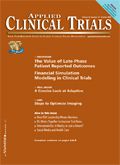A Canary in a Coal Mine?
Applied Clinical Trials
How the ability to apply text mining and signal detection algorithms to social media's real-time data provides unheard of value.
As consumers grow more comfortable with blogs, Facebook, Twitter, and other social media, the available public comment regarding life sciences gets both richer and more treacherous. At the time I started writing this article, the focus was on the text mining of social media to identify very early potential safety signals. But since then, news of the H1N1 influenza virus (swine flu) has already come, and mostly gone and come again. The speed with which news of this virus spread has more to do with social media than the Internet itself.

Only one or two years ago, news of the virus would have appeared first on mainstream news sites, followed by emails to friends and family referencing the link. In 2009, the media truly is the message. Friend networks, RSS feeds, tweets, and other messages spread news of the potential flu pandemic via its own social media pandemic.
Real-time riches
There is rich and useful life sciences content within social media. For example, the HPV vaccine was approved for use in the spring of 2006. Shortly thereafter, the recipients of the vaccine (primarily teenagers) began documenting their experiences online through various, often personal, social media outlets.
That information, because it was delivered through social media outlets, was available virtually immediately to not only individual readers but also Web 2.0 systems that can interpret and analyze this content. While there may not be any true concerns associated with the HPV vaccine, the ability to apply text mining and then accompanying signal detection algorithms to real-time data provides unheard of value regarding early signal detection and drug safety.
Drug safety today is dependent on spontaneous adverse event reporting, with growing interest in eHealth records and claims data. None of these data sources is available in real time. Further, transactional systems such as these are proprietary and subject to privacy regulations.
There is little doubt that these data sources are rich and may ultimately provide the most comprehensive data to identify true safety signals, but they are unacceptable when speed is of the essence. The true early warning system lies in the ability to mine and analyze the real-time data available through social media.
Digital radar
To see how this would work, let's look into a potentially very real future, where a new, virulent, flu virus is spreading rapidly, and a new vaccine has been distributed.
It is easy to imagine clinics administering vaccinations around the clock, but how can success or failure be rapidly determined? Certainly, government officials will look to sentinel caregivers to report flu-related clinic visits, but even that information will take time to aggregate and review. Instead, imagine Twitter being used to surface data about the number of flu patients seen and vaccinated. That information, however anecdotal, is available within minutes. And it can be the early warning system that indicates success or failure, and enables health officials to quickly take the most appropriate steps.
Social media is rapidly evolving, and it is unclear exactly what role it will, or should, play regarding health care and life sciences. What is clear is that social media will play a role. We can either dismiss it is as anecdotal information or embrace it as a digital canary in a coal mine, alerting us to potential problems long before we can sense them ourselves. ?
David Handelsman R&D Manager SAS Health and Life Sciences Global Practice
